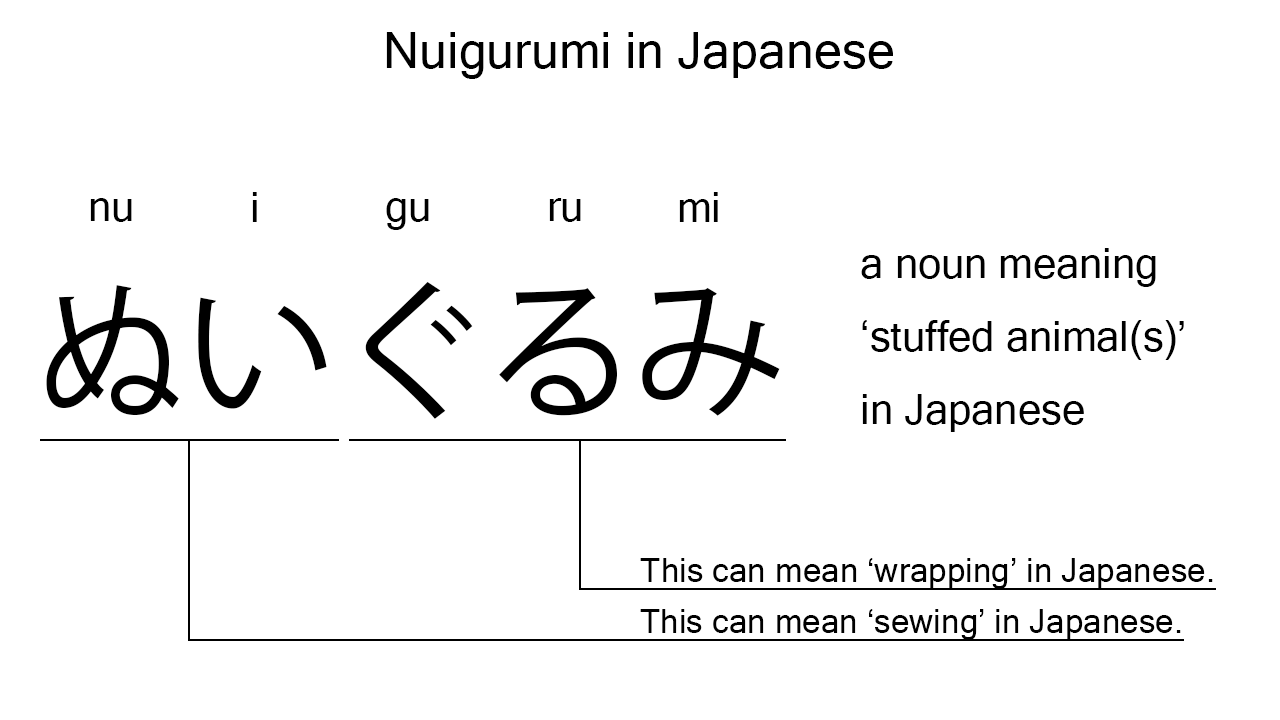What does “nuigurumi” mean in Japanese?
Native speakers say “nuigurumi” often to mean ‘stuffed animal’ in Japanese. Perhaps, some Japanese learners know this word as it is sometimes used in Japanese movies, songs, novels, manga, anime, and the like. In this blog post, however, I will explain this word in detail based on its grammatical components. And also, I will explain how to use it through example sentences. My explanations would help Japanese learners understand “nuigurumi” more clearly. Then, let’s get started!
Contents
Definition and meanings of “nuigurumi”
Let me start with the definition and meanings of “nuigurumi”.
- nuigurumi – ぬいぐるみ : a noun meaning ‘stuffed animal’, ‘plush toy’, ‘soft toy’, or such in Japanese. This can also work as plural. Learn more about Japanese plural.
The definition and meanings are not that difficult, I think. To understand this noun more clearly, however, let me explain its grammatical components in detail, one by one.
What does “nuigurumi” literally mean in Japanese?
“Nuigurumi” consists of the following two components:
- nui – ぬい : can be considered as the noun form of the verb, “nuu”, which means ‘to sew’ in Japanese.
- gurumi – ぐるみ : can be considered as the noun form of the verb, “kurumu”, which means ‘to wrap’ in Japanese.
From these two components, we can understand that “nuigurumi” literally means ‘sewing and wrapping’ in Japanese. This literal interpretation is not completely in line with the actual meanings, but still understandable, I think. Stuffed animals are often made by sewing cloth and wrapping soft material.

When we meet new Japanese words, we should check their grammatical components in detail to understand their meanings clearly and deeply. In many cases, grammatical components tell us a lot about the meanings of the words they form. Actually, here, we could get the better understanding of “nuigurumi” through the detailed check above.
So far, I’ve explained the definition and meanings of “nuigurumi” together with its grammatical components. Then, let me explain how to use it through the example sentences below.
Example #1: how to say “stuffed animals” in Japanese
watashi no imouto wa nuigurumi ga suki desu – 私の妹はぬいぐるみが好きです (わたしのいもうとはぬいぐるみがすきです)
My little sister loves stuffed animals.
Below are the new words used in the example sentence.
- watashi – 私 (わたし) : a pronoun meaning ‘I’ in Japanese.
- no – の : a case particle used after a noun or pronoun to make its possessive case. In the example, this is used after “watashi” to make its possessive case, “watashi no“, which means ‘my’ in Japanese.
- imouto – 妹 (いもうと) : a noun meaning ‘little sister’ in Japanese. This can also work as plural.
- wa – は : a binding particle working as a case marker or topic marker. In the example, this works after “watashi no imouto” to make the subject in the sentence.
- ga – が : a case particle used to make the subject word or the object word in a sentence. In the example, this is used after “nuigurumi” to make the object in the sentence.
- suki – 好き (すき) : the stem part of the na-adjective, “sukina”, which means ‘favorite’ in Japanese. Native speakers, however, often use this as an individual word to mean ‘to like’ or ‘to love’ in Japanese. In the example, this is used to mean ‘to love’.
- desu – です : an auxiliary verb used after a noun or adjective to make it polite. In the example, this is used after “suki” to make it sound polite.
This is a typical usage of “nuigurumi”. In this example, it works together with the case particle, “ga”, to become the object in the sentence.
Example #2: another usage of “nuigurumi”
kanojo wa atarashii nuigurumi wo kat ta – 彼女は新しいぬいぐるみを買った (かのじょはあたらしいぬいぐるみをかった)
She bought a new stuffed animal.
Below are the new words used in the example sentence.
- kanojo – 彼女 (かのじょ) : a pronoun meaning ‘she’ in Japanese.
- atarashii – 新しい (あたらしい) : an i-adjective meaning ‘new’ in Japanese.
- wo – を : a case particle used to make the object word in a sentence. In the example, this is used after “atarashii nuigurumi” to make the object in the sentence.
- kat – 買っ (かっ) : one conjugation of the verb, “kau“, which means ‘to buy’ in Japanese. In the example, it has been conjugated for the better connection with its following word.
- ta – た : an auxiliary verb used after a verb, adjective, or auxiliary verb to make its past tense form. In the example, this is used after “kat” to make its past tense form, “kat ta”.
This is another typical usage of “nuigurumi”. In this example, it works together with the i-adjective, “atarashii”, to mean a ‘new stuffed animal’ in Japanese. When we want to mean a ‘stuffed animal’ or such in Japanese, anyway, this noun is always a very good option.
Summary
In this blog post, I’ve explained the definition and meanings of “nuigurumi” in detail based on its grammatical components. And also, I’ve explained how to use it through the example sentences. Let me summarize them as follows.
- nuigurumi – ぬいぐるみ : a noun meaning ‘stuffed animal’, ‘plush toy’, ‘soft toy’, or such in Japanese. This can also work as plural. This noun literally means ‘sewing and wrapping’ in Japanese. This literal interpretation is not completely in line with the actual meanings, but still understandable, I think. Stuffed animals are often made by sewing cloth and wrapping soft material.
Hope my explanations are understandable and helpful for Japanese learners.
Leave a Reply